Tribute to Dr. James C. Windsor: Part I, The Program in Gaines Theater
by A. Jane Chambers
|
An enthusiastic audience of at least 200 gathered in Christopher Newport University's new Gaines Theater on Friday, February 10, 2012, to pay tribute to Dr. James C. Windsor, the second president of what was Christopher Newport College during his presidency (1970-79). Dr. Windsor served CNC beginning as Instructor of Psychology in 1962-63, the college's second year, when the campus was the old Daniel Elementary School on 32nd St. Soon he proved to be most effective in administrative positions as well as teaching. He was Dean of Students and Director of the Counseling Center before becoming president.
His academic degrees were a B.A. from the College of William and Mary, a B.D. from Colgate Divinity School, an M.S. from Virginia Commonwealth University, and then a doctorate from the University of Virginia, which he earned while also serving as CNC's president.
As guests gathered and signed in for Friday's program, they were entertained with a slide show of photographs reflecting Jim Windsor's life at Christopher Newport. These were provided by family members and former students as well as CNC publications such as the Trident yearbooks.
President Paul Trible opened the program at 4:30 p.m. by welcoming the audience and introducing James L. Windsor, the son of James C. and Joan Windsor. A lawyer with Kaufman and Canoles in Virginia Beach, young Jim talked of the important lessons he had learned from his father--not merely through his father's words but, more importantly, through his behavior, his example. So sincere and warm was this reflection about Dr. Windsor as husband and parent, that at the conclusion of his speech, the audience not only applauded vigorously, but stood up while doing so.
| |
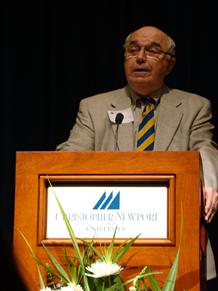 |
| Professor Emeritus Barry Wood speaking. Photo by Ellen Babb Melvin. |
|
|
| The second speaker was Dr. Barry Wood, who focused on the senior Jim Windsor as colleague, friend, college teacher and counselor to CNC's students. He recalled a friendship that has lasted since 1962 and the bonding of the Wood and Windsor families. As had the son, the friend also gave examples of James C. Windsor's wonderful sense of humor. Barry closed his speech by reading an account of how Dr. Windsor the counselor and caring man had saved the life of one of CNC's students in the 1960s who was suffering from severe depression and contemplating suicide. Again, the audience stood as it applauded enthusiastically at the end of Dr. Wood's presentation. This student's true story will be published soon here on the website.
Next on the program was a special presentation by President Trible, the awarding of a plaque to Dr. Windsor, several photos of which can been seen here. It depicts the outside view of the wing of Freeman Center where the James C. Windsor Center is located.
Dr. Windsor's remarks--brief and typical of him--focused on others rather than on himself. After regretting that his wife, Joan, was unable to attend, he asked his other immediate family members to stand--son Jim, daughter Robin, their spouses and his seven grandchildren. Then he thanked his son, Barry Wood, and President Trible for the wonderful program. He also thanked the three authors of Memories of Christopher Newport College: The First Decade (Barry, Rita Hubbard, and I) for bringing attention to the early history of CNC/CNU and thanked me yet second time for bringing the First Decaders back to their important place on the campus. After all this thanking, he next told an amusing anecdote about the streaking episode on our campus in the late 1970s, when about seven totally nude male students streaked a Friday afternoon faculty meeting in Newport Hall's lecture room, after which "the faculty clapped and whistled as they ran out the door." The streakers had interrupted President Windsor's budget report, and after they left, he commented that he had wanted to show the faculty some figures, but those were not the figures he had in mind.
At the conclusion of Dr. Windsor's remarks, the audience stood and applauded with great enthusiasm. After he left the stage, President Trible invited everyone to go next to the Windsor Center for the Dedication (including a ribbon-cutting ceremony) and the Reception. These events will be covered in Part 2 of the Tribute.
|
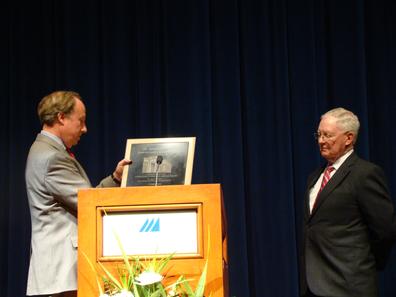 |
| President Trible presenting plaque to Dr. Windsor. Photo by Ellen Babb Melvin. |
|
|
 |
| Dr. Windsor expressing thanks to many. Photo by Ellen Babb Melvin |
|
|
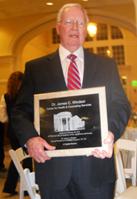 |
| Dr. Windsor poses with his plaque. Photo by Nita Smith. |
|
|
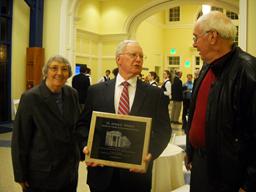 |
| Dr. Windsor with Dr. Chambers & First Decader Bill G. Smith. Photo by Nita Smith. |
|
|
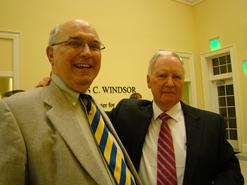 |
| Friends since 1962: Dr. Wood and Dr. Windsor. Photo by Ellen Babb Melvin. |
|
|
Windsor Tribute: Part I Continued, Son's Speech and More Photos
by A. Jane Chambers
|
At my request, Dr. Windsor's son, James L. Windsor, sent me a copy of his speech, which is reprinted below in its entirety. The photos here were provided by Dr. Windsor's daughter, Robin Rice, and by CNU's Assistant to the President, Margaret Yancey. The CNU photos were taken by the University's professional photographer, Jesse Hutcheson.
|
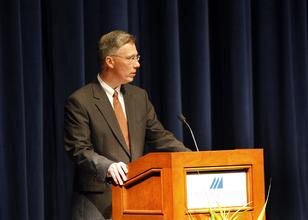 |
| James L. Windsor speaks about his father. Photo by Jesse Hutcheson, CNU photographer. |
|
|
Comments by James L. Windsor on the Dedication of the James C. Windsor Health
and Counseling Center, February 10, 2012, in the Gaines Theater
Thank you, Paul, for those kind words [of introduction]
It is with great pride, humility and absolute pleasure that I have the privilege to stand before so many old and dear friends, our family, former students, colleagues and many others and share some thoughts on my father.
Many of you know Jim Windsor as (1) the second president of Christopher Newport College; (2) the first dean of students; or (3) as a dedicated teacher.
Others of you know Jim Windsor as the Marine who was awarded a Naval Commendation for Valor and a Purple Heart for wounds received in combat in Korea.
Some of you know Jim Windsor, who was deeply involved in community service on the Peninsula for many years.
While I know the man well in all of these roles, my perspective here today is different and unique, shared only by my sister, Robin, who is here with her family, and that is as a proud and devoted son of a dedicated and nurturing father.
|
In addition to my father teaching me life skills like (1) how to properly shoot a lay-up; (2) how to change the oil in a car; and (3) that there is no substitute for hard work, he taught me several cardinal rules for effective public speaking which I thought I had better strictly follow today:
1. Be brief. Now, as a lawyer, I can be long winded anyway, but you get me talking about my father and I can go on for hours. However, my father often said, "Brevity is the hallmark of every well-received presentation," -- so I will be brief.
2. Express appreciation to those involved in planning the event. So let me take a moment to thank President Trible, Margaret Yancy, Amie Graham, Barry Wood, Jane Chambers, and many others who have contributed to this celebration, and also thank each of you for coming here and sharing in this moment. We have almost 200 people here today and we are so appreciative of you being here.
3. Humor. My father always suggested including a little levity or humor in every presentation. I have a very thick file of jokes and humorous tales which my father has shared with me over the last 30 years which I have used in many presentations. Now,most of the advice that I have received from my father has been right on. But, Dad, I hate to say this in such a public setting, but some of those jokes just didn't go over that well!
Let me pull one from the Jim Windsor archives and see how it goes over here. Now, since this is his special day and you know it is his joke, please feel free to laugh hysterically!!
JOKE:
A cannibal goes into the butcher shop to buy some human brains. He sees that:
accountants' brains are $10 a pound;
doctors' brains are $20 a pound;
rocket scientists' brains are $30 a pound; and
lawyers' brains are $80 a pound.
The cannibal asks the butcher, "Why are the lawyers' brains $80 a pound?" The butcher says, "Do you know how many lawyers' brains it takes to make a pound?"
4. Finally, he advised connect with the audience and touch their heart if appropriate.
I was ten years old when my father became president of Christopher Newport College in 1970 and, by all accounts, I was a real handful.
I'm sure President Trible would agree that the job of a college president is extremely demanding, with many nights out away from the family. However, I can tell you that when my sister and I were growing up, despite these pressures and being pulled in many different directions, he was always there for us. He found a way to strike a balance between succeeding in his professional life and also succeeding in his personal and family life and raising his children. This is one of the many great legacies that he has passed on to my sister and me as we raise our own children.
|
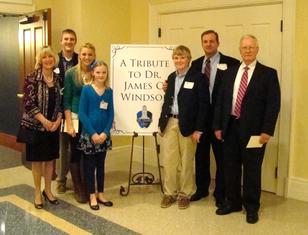 |
| Dr. Windsor with daughter Robin and her family. Rice family photo. |
|
|
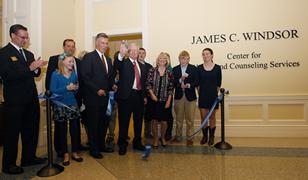 |
| Windsor family cuts ribbon at Center Dedication. Photo by Jesse Hutcheson, CNU photographer. |
|
|
Recently, I shared stories with one of my father's good friends who has known him for over 40 years. She observed that, among his most endearing qualities, is that he is humble; he doesn't seek praise or the spotlight. Now, because he is modest and thought he left the stage years ago, he has been a little embarrassed by all of the attention he has been receiving recently. He told me a couple of weeks ago, "This is too much fuss." Well, dad, we are all here to shower just a little more attention on you.
My father's friend also commented on my father's strong faith. He's always been that way. He grew up with that faith, was ordained as a chaplain and always kept that faith. This strong faith is another legacy instilled in his children to be passed along to our children.
In 1987, I returned to the Peninsula, where my father had lived, worked and been involved in the community for over 30 years, to practice law with Kaufman & Canoles. As I met various business people and civic leaders, starting out here on the Peninsula, I was often asked by folks, usually with a sense of warmth and admiration, "Are you Jim Windsor's son?" There was no greater compliment or source of pride than that question.
When I was born, I didn't know that my father would be my mentor, my trusted advisor and best friend.
I didn't know, that he would be a constant source of strength and support, always ready to help in a kind and thoughtful way, standing with me in happy times as well as challenging times.
I didn't know, that he had been shot, burned, and had learned through the ravages of war how precious life is and from this he would teach my sister and me that "every day is a gift."
I didn't know that, his seven grandchildren would always treasure the times at "Camp Grandpa's" and that he would bring them such joy and comfort.
But now I know that, as a college president, a teacher, a father, a husband, a Marine, a friend and colleague to many in this room, you [addressing his father directly] kept the faith, were always there with an extended hand of support and unwavering dedication.
But now I know that, your patience, sense of humor, humble nature, intellectual curiosity and unflinching commitment to family would be characteristics that would define you throughout your life.
Although there are many things that I didn't know, I know this--you are the finest man I have ever known. You are the finest man I will ever know.
|
 |
| President Trible presents plaque to Dr. Windsor. Photo by Jesse Hutcheson, CNU photographer. |
|
|
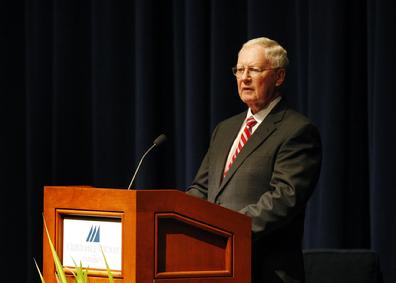 |
| Dr. Windsor speaks after receiving plaque. Photo by Jesse Hutcheson, CNU photographer. |
|
|
Windsor Tribute Continued: How Jim Windsor Saved Dalton's Life
BACKGROUND: Guests planning to attend the Windsor Tribute were asked to submit memories they had with Dr. Windsor for possible inclusion in the program. The memory piece below was included in the speech given on February 10, 2012, by Dr. Lawrence B. (Barry) Wood, Jr. as his conclusion. It most effectively demonstrates Jim Windsor's major impact in the lives of some of his students.
A. Jane Chambers
|
Asking the Next Question
by Dalton Kelley Blankenship
In the fall of 1967 I returned to CNC to take the few courses I still needed to finish my AA degree. The young man with whom I had fallen in love at 16, Norman Blankenship, had married me in August; but then he often left me, courtesy of the United States Navy and Vietnam. I was alone a great deal. A clinical depression that I thought I had conquered at 17 returned, then got worse, and I knew I needed help. My family, close by, recognized the return of my symptoms. Norman and my family helped me realize that school was more than I could handle, so I decided to withdraw. And that was when my life changed dramatically.
To withdraw, I had to make an appointment with Mr. Windsor, who was then the Dean of Students. I knew who he was, because Norman had worked with him as President of the Student Athletic Association, but I had never spent any time with him at all.
I was in pretty rough shape by this time. I felt that I had failed Norman and myself. I wanted to complete the degree so that I could continue on and get a BS. I felt time was running out somehow. As I sat in Mr. Windsor's office, he intuitively recognized that there was more to the story than just needing to withdraw—he asked the next question—and the next. He then told me he was a licensed counselor and asked if I would be willing to come back. It seemed like a door had opened, with faint hope behind it, and I agreed.
Over the next couple of months, we met off and on and I felt that I was getting better. But then I quit going for awhile and tried to make it on my own. I got considerably worse, especially when Norman was away. And he was gone more than 250 of that 365 days of our first year together. It was the absolute worst time he could have been away. When he was gone, I went to my parent's home, but wanted to be in our apartment; when I was in the apartment, I was so lonely without him, I wanted to be anywhere but there.
|
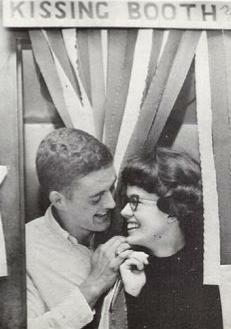 |
| Norman and Dalton at CNC in 1966 |
|
|
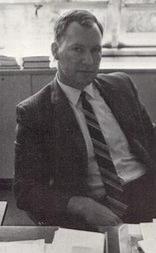 |
| Jim Windsor at his desk in 1967 |
|
|
One afternoon, I arrived for my appointment with Mr. Windsor having a vague awareness that I had no idea how I had gotten there, but knowing that I had driven myself. It was as if I knew I was present, but most of my conscious self was somewhere else. As we talked, I felt at peace—very strangely at peace. And then I was aware that the tone of the conversation had changed. He came around his desk and sat beside me. He told me that he had a speaking engagement in Williamsburg. He needed to make a phone call in order to cancel it. He asked me if I would be willing to sit and not move until he returned. I agreed.
When he returned, he reviewed our "conversation." It seems he had done it again. Asked the next question. He had asked me if I wanted to kill myself. And then he asked me if I had a plan, and what it was. I told him that I did plan to kill myself as soon as I got home with a stockpile of pills. It had just gotten too hard to keep myself above water, so to speak. Everyday it was a struggle just to sit up in bed, not to mention getting out of it. Trying to figure out what to wear was impossible; trying to smile a forgotten action. I just couldn't do it anymore. The darkness was too palpable and I just could not stop the slide into the pit anymore. I could not even think of returning to the nightmare of what the hospital had been when I was 17.
He asked if I would trust him that he knew it could be better; that medication was available now that was not then; that he could refer me to a physician that could prescribe it; that we could meet more often; that he could see Norman; that we could all three meet together if necessary; that my life mattered. He would not let me leave until I was able to promise not to harm myself—convincingly—to give him a chance to prove his promise to me. And I did. And he did.
Because he asked that next question that day, I was later able to receive that almost elusive AA degree from the hand of Jim Windsor in 1971, and I am here this day to share this story. And our daughter, who was born in 1972, and had her Godfather Jim Windsor present at her Christening, Jessica Windsor Blankenship Ervin, is also here. And our son, Joshua Blankenship, is here as well. Both are married and deliriously happy, as are we that we have been blessed to have them in our lives.
Important also, I think, are the children, adolescents, families and adults who have benefited from my practice as a psychiatric RN, and my general practice of nursing. Hundreds of these folks have sat with me over the last thirty odd years as I have listened to them tell me their stories—and then, I have asked them the next question. It is a gift I was given on a late afternoon in 1967 by a friend who thought my life was worth something—and made me believe it. I have been, and will forever be, in his debt.
|
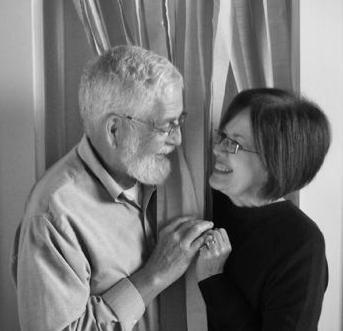 |
| Norman and Dalton in 2011 |
|
|
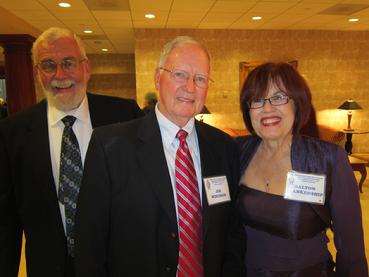 |
| The Blankenships with Dr. Windsor at the First Decaders Reunion, CNU, Sept. 2011 |
|
|
P.S. : In addition to that AA from CNC in 1971, Dalton earned an RN from Riverside School of Professional Nursing in 1977 and a BS in Psychology from CNC in 1985.
Jane
|
Windsor Tribute, Part II: Dedication and Reception
by A. Jane Chambers
At the end of the Gaines Theater Program, President Trible invited the audience to follow him and the Windsor family to the Windsor Center for a brief Dedication, including a Ribbon-Cutting by members of the Windsor family and a Reception. Below are before and after photos of members of the Windsor family cutting the ribbon. In both photos, left and right of Dr. Windsor (in the center) are his son and daughter: James L. (Jim) Windsor and Robin Windsor Rice. The gentleman to the far left in each photo is CNU's Director of Counseling Services, Dr. William (Bill) Ritchey. All others in the photo are members of the Windsor family.
The Windsor Center consists of two parts. In both photos, the group is standing in front of the entrance to the Counseling Services; on the other side of the Windsor Center name is the the entrance to the Health Services.
|
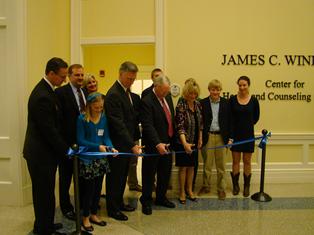 |
| Photo by Ellen Babb Melvin |
|
|
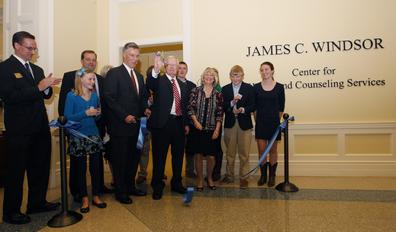 |
| Photo by CNU photographer Jesse Hutcheson |
|
|
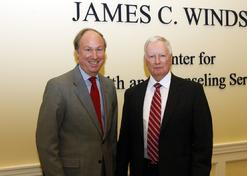 |
| The 5th & 2nd presidents. Photo by CNU's Jesse Hutcheson |
|
|
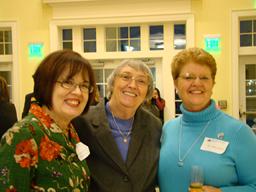 |
| First Decaders Dalton K. Blankenship (L) & Ellen Babb Melvin (R) with Dr. Jane Chambers. Photo by Kathy Babb Dansey |
|
|
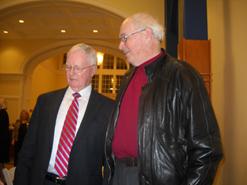 |
| Dr. Windsor and First Decader Bill Smith. Photo by Nita Smith |
|
|
 |
| First Decaders Dalton & Norman Blankenship, Ellen Babb Melvin, and Wayne Rammell. Photo by Kathy Babb Dansey |
|
|
 |
| Doctors Barry Wood, Jane Chambers, and Jim Windsor. Photo by Ellen Babb Melvin |
|
|
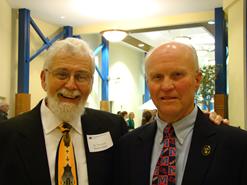 |
| First Decaders Norman Blankenship & Wayne Rammell. Photo by Ellen Babb Melvin |
|
|
Windsor Tribute Conclusion: Dr. Barry Wood's Speech
At my request, Barry Wood sent me a copy of his tribute to Dr. Windsor, which is printed below except for the conclusion, which was previously printed on this website as "How Jim Windsor Saved Dalton's Life." This story is accessible through the Windsor Tribute tab in the left column here.
A. Jane Chambers
|
TO JIM
by Lawrence Barron Wood, Jr.
What a pleasure it is for me to be a part of this day of celebrating Jim Windsor, my friend--and to have this celebration begin in this place, the new John Gaines Theatre. It was Jim Windsor's idea born during his dialogue with Frosty Coile about CNC's initial Student Center that it include a theatre. And then it was Jim's exceptional effort during the General Assembly's budget debates that protected the theatre's presence in the Student Center.
Later, during the Presidency of Jack Anderson, the late Billie Milner and his client, John Gaines, began to discuss a gift and giving plan to CNC that would eventually add up to three quarters of a million dollars. John Gaines had developed a deep appreciation for CNC over a number of years--it seems he had come to the then John Smith Library every day after his work managing J.C. Penney in New Market Shopping Center to study each day's Wall Street Journal and then to make all those investment decisions that would lift him above his salaried life and place him among the millionaires. Billie Milner and Jack Anderson crafted a proposal to honor John during his lifetime and thus Jim Windsor's unnamed theatre became the first John Gaines Theatre.
Let me ask you to join me in thanking the University's Board of Visitors and President Trible for this glorious extension of the meaning of John Gaines to the history of private support of CNC-CNU.
Now, to today's Man of the Hour--his many titles while working here speak the growing nature of this place.
1. First Professor of Psychology
2. First Director of Counseling
3. First Director of the Evening College and Summer Session
4. First Dean of Students
5. Second President
6. First President of CNC as an independent public college in the Commonwealth of Virginia.
All of these achievements were within 14 years and before he was 43 years old.
I first met Jim 49 years ago in mid-September at Scott Cunningham's opening orientation at the onset of CNC's second year, the 1962-1963 session. Again Scott assembled us in the cool basement of the John W. Daniels School whose history was in the fifth stage of evolving into a new function. Four-storied, high ceilings, heavily waxed floors, and grassy spots long hidden beneath black top, sided by rusted fire escapes, the same face presented to 31st and 32nd Streets--that was what Scott Cunningham had to pull all of us into believing was a branch of the College of William and Mary in Williamsburg. As a veteran of CNC's first year, I had already come through the mind opening consciousness of the very peculiar and positive experience of serving in a minimalist college.
|
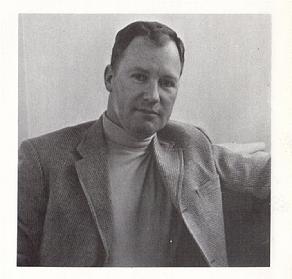 |
| Psychology professor Jim Windsor. CNC TRIDENT photo. |
|
|
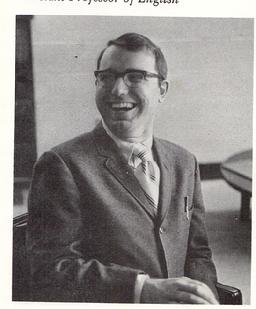 |
| English Professor Barry Wood. CNC TRIDENT photo. |
|
|
 |
| President Windsor with student in 1971. CNC CATALOG photo. |
|
|
Within a week, Jim and I were eating lunch together several times per week, always having to walk unharmed through the gauntlet formed on Washington Ave. by shipyard workers come to watch certain walkers, thereby gaining material for the fantasies that would get them to the day's end. Our favorite eating place was just off Washington Ave. on 32nd Street. While I've forgotten its name and it has left the city's memory, I still remember vividly its hot Parker House rolls--butter dripping onto the plate--and above all, its corned beef hash which is still the best I've ever eaten. There, in this slim place, we found each other's sense of humor to be a good fit and also we found that our own intellectual lives could both re-enforce and extend our mental growing. He had studied under Dr. William Hamilton, at that time one of the world's most influential theologians. I was then deeply involved in Dostoevsky's Crime and Punishment.
Even today, eating lunch is the center of our togetherness--but now we eat in Williamsburg at the Chickahominy House. Jim loves the chicken and dumplings and I, their Smithfield ham bisquits and Brunswick stew. Now, our talk is directed to what we think we remember, and on occasion, about our readings as we are passing through this all important duty of waiting for our meals. Still, we end with Jim offering a "joke to remember"--his last one I still think I remember:
Two attractive young ladies were walking beside a lake on a very hot day when they decided impulsively to take off their clothes and go swimming. A man soon appeared on the shore with a bucket in his hand. In shock, the girls told him that they would not rise out of the water until he had left the lake. The man said, "Girls, I'm not interested in seeing two naked women. I'm here to feed the alligators."
Over our 49 years, I have known Jim only as a man held by the abiding power of a core of values. And at the center of that core is his essence--He is Trust and he is Trustable. Our students who came to him as counselor knew that; our faculty entering their classrooms to teach as their high purpose required, knew that; President Tom Graves of William and Mary knew that; members of the General Assembly knew that. And before all of us in the CNC family knew Jim as Trust, the U.S. Marine Corps knew that when they turned his trust into the assignment in the Korean War to walk into battle areas where bombs had been secretly planted by the enemy and put his calm fingers down into the dirt to find and remove the bombs' fuses.
My friend Bill Saunders constantly reminds me that our Latin Professor at Hampden-Sydney College, Dr. Graves Thompson, taught us about those interconnecting spirit making attitudes that make a man of Trust. For Dr. Thompson, Cicero had captured every aspect of Trust in 3 words--Integritas, Gravitas, Humanitas.
Integritas : that aspect of a person that shows itself as being firmly unified, adhering constantly to a code of discourse, decision making and action.
Gravitas : that aspect of a person that radiates dignity and authority--that causes others to grow attentive and intentive.
Humanitas : that aspect of a person that exudes positive feeling for humankind such that even the perception of frailities does not endanger believing that the human condition can become more perfect by the awesome work of increasing the real presence of Reason and Reasonableness.
Since today is the University's moment to place before the public the Dr. James C. Windsor Center for Counseling, I will close by sharing a student's experience with Jim--as counselor.
[Here Barry read Dalton Blankenship's story, then concluded thus:]
And so, it is a manifestation of the University's Best that today it places the name of James C. Windsor on the wall of the University's Center for Couonseling and Wellness where it will ever recall its founder for those who knew him and ever stimulate the curiosity of those who have need of the Center's services.
Barry Wood
Feb. 10, 2012
|
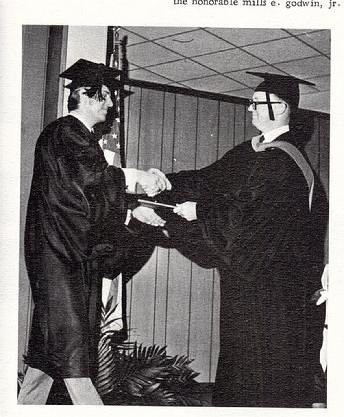 |
| President Windsor awarding 1st 4-yr. degree to Wayne Barry, June 1971. CNC TRIDENT photo. |
|
|
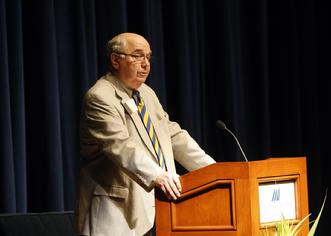 |
| Barry Wood speaking about his long-time friend and colleague Jim Windsor. CNU photo by Jesse Hutcheson. |
|
|
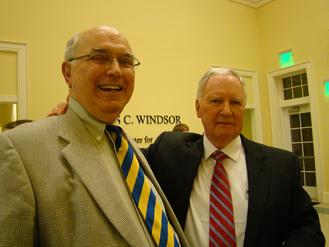 |
| Barry and Jim celebrate the Dedication of the James C. Windsor Center. Photo by Ellen Babb Melvin. |
|
|
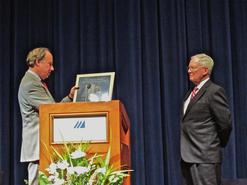 |
| President Trible presenting plaque to Dr. Windsor. Blankenship family photo. |
|
|
 |
| Barry and Jim pose with Jane and Dalton. Blankenship family photo. |
|
|
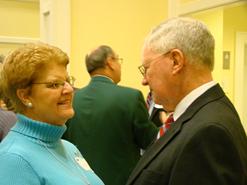 |
| Dr. Windsor chats with former student Ellen Babb Melvin. Photo by Kathy Babb Dansey. |
|
|
|